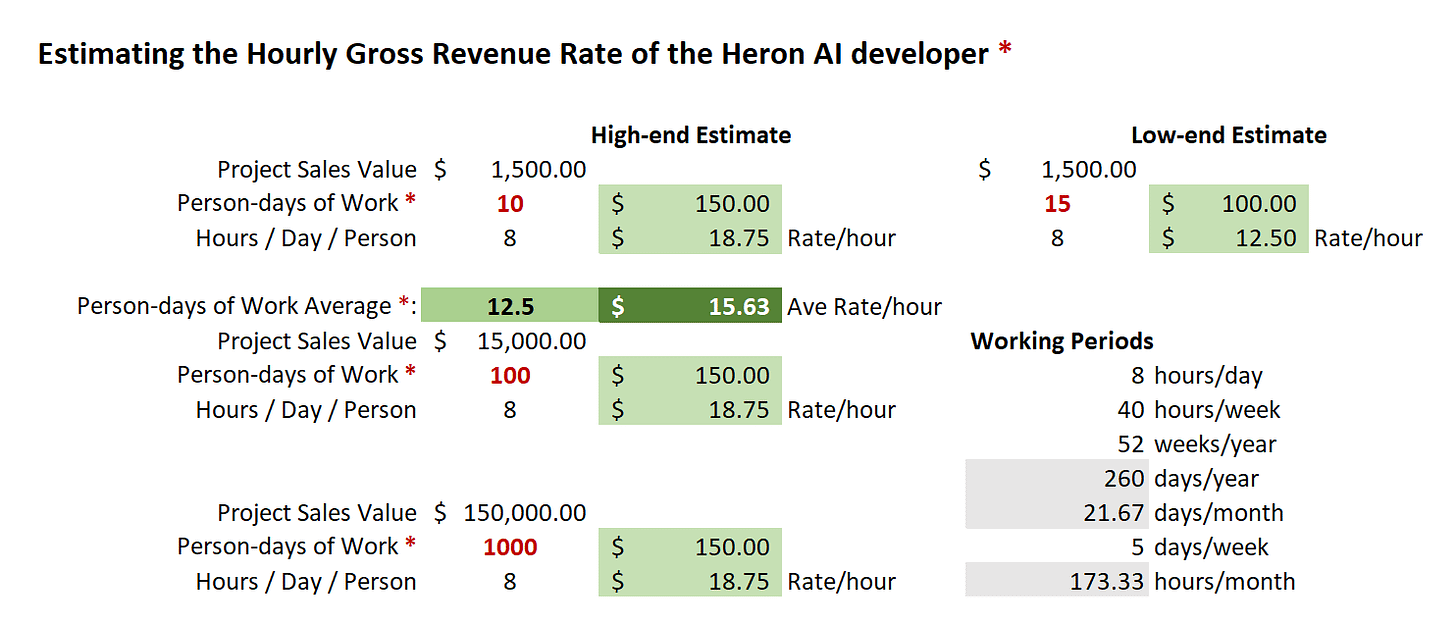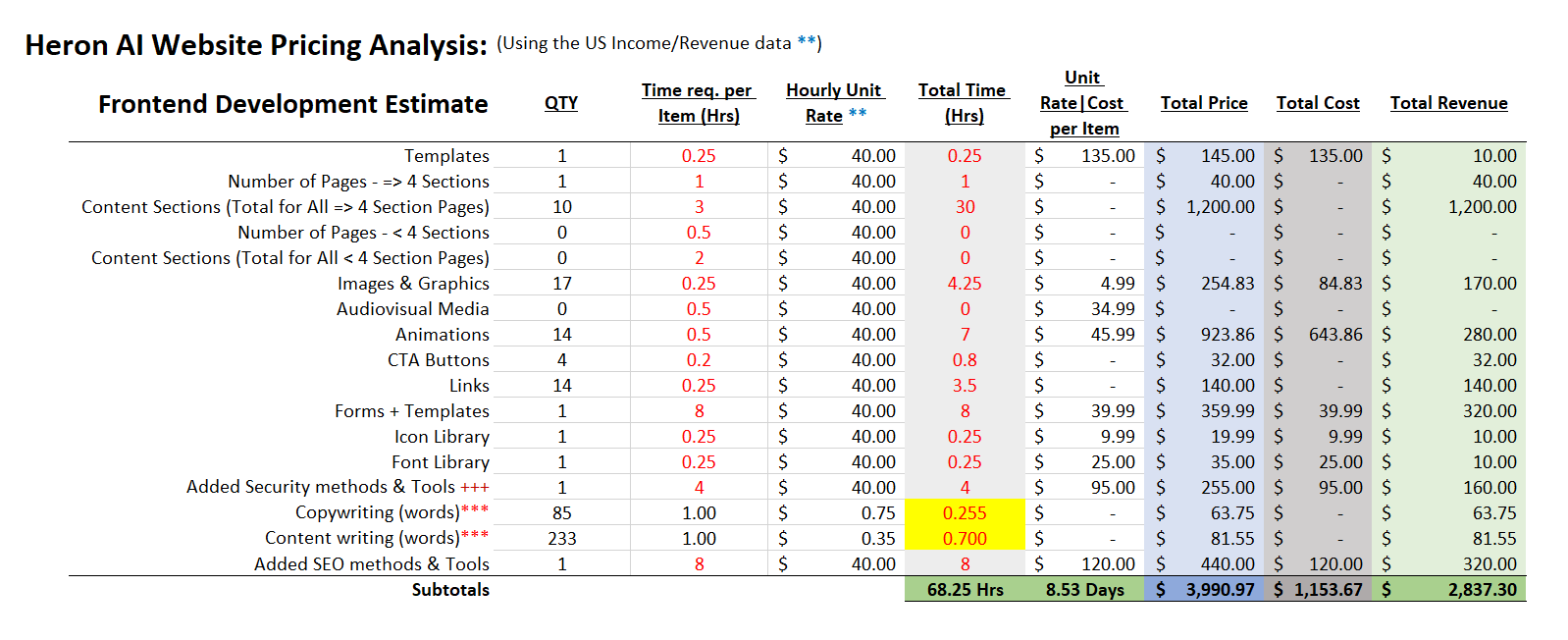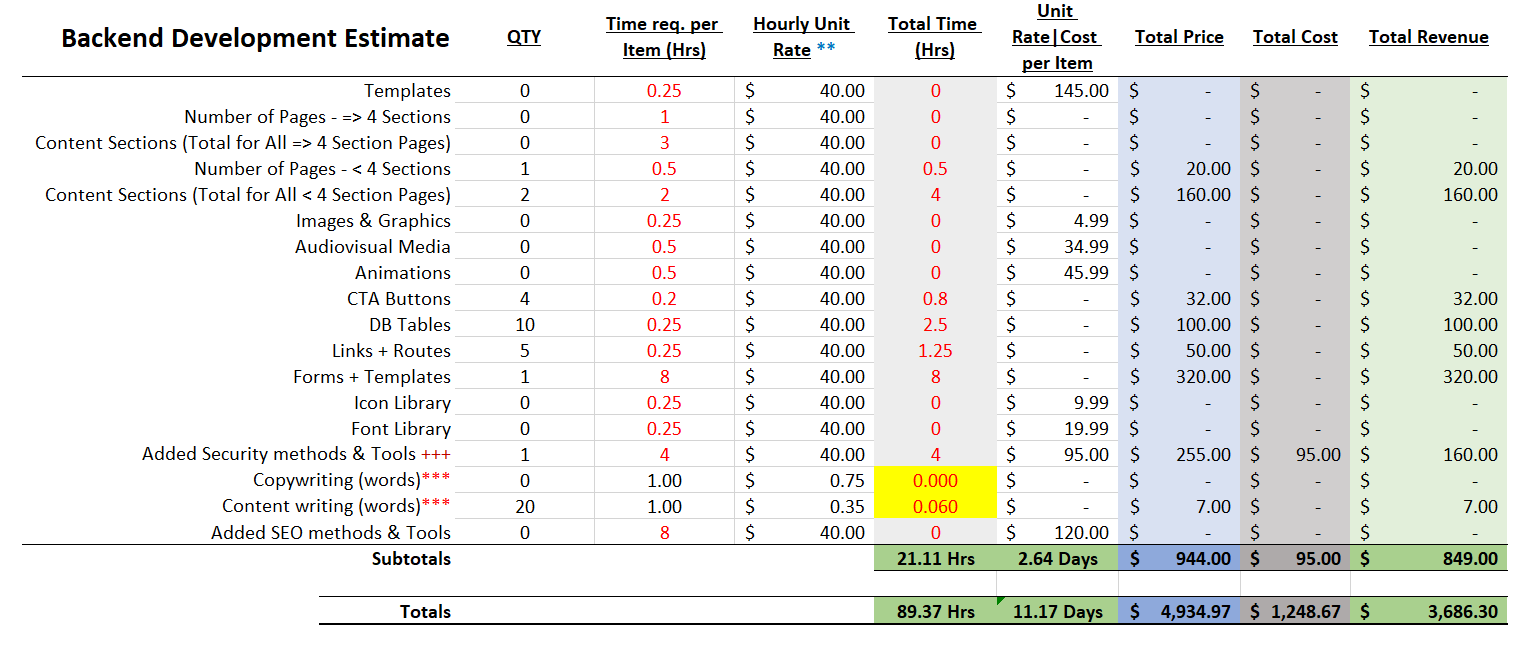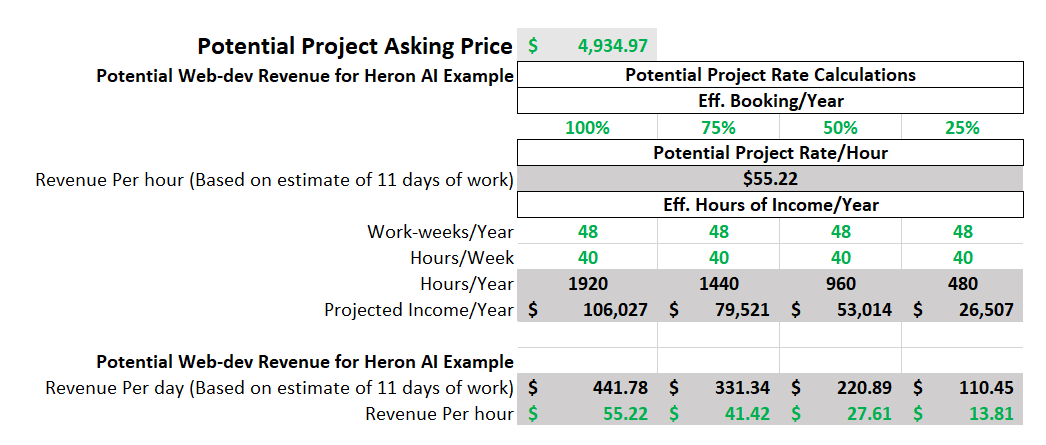Freelancing—Pricing Myself in The Open Market—Objectively Part 2
This is the second part of an opinion which is based on a question I discovered on u/Entrepreneurs, one of the Reddit threads I enjoy.
Reading time Approx. 25 min

“The moment you make a mistake in pricing, you're eating into your reputation or your profits.”— Katharine Paine
Part II
This is the second part of an opinion which is based on a question I discovered on u/Entrepreneurs. The aim of Part II is to provide a set of tools with which we can determine a more accurate price for web development work. It simplifies to a table of variables that can be expanded or reduced, depending on the specifics of the project.
There are also some suggestions on how very small businesses can become a valuable source of revenue for developers without it becoming a PITA.
Part I Recap
Is 1k Expensive For a Full Website?
Found on Reddit u/Entrepreneurs.
(You can find Part I here in case you miss the history behind all this)
The price range for websites is quite broad and diverse. It’s not that complicated once things get broken down into more digestible parts.
Referring to the Reddit post it is noticeable that the prices given for developing WordPress sites range from about $500 to $50k, but there is mention of custom Content Management System (CMS) sites that went for $500k. Those can be WordPress based or designed around frameworks like Drupal, Laravel or .NET to name a few.
The Wall of Uncertainty Revisited
Taking the Heron AI app as a working example, let’s investigate the possibility of finding a suitable approach with which we can estimate development costs with more certainty and accuracy.
Assuming the web developer knows their development tools, it probably took about what; (A)ten to (B)fifteen days** of work to develop Heron AI? With the asking price of $1500, this puts the hourly rate roughly between (B)$12 - (A)$20 per hour. (**these estimates are founded on the more detailed analysis further below)
With the given asking price though, it seems to indicate the developer probably earns in the $26-$36K region if they are booked full throughout the year. And this is The Wall of Uncertainty most of us face.
How well-booked is the average freelance web developer?
At 50%-booked on average over a year, they’ll average about $8.40 per hour in gross revenue. Can the developer live with that? It's for them to know and make the call.
Should such a developer consistently churn out good work and retain clients, then things look rosier. But it's always a tricky setup to maintain the balance of servicing current clients vs taking on additional clients, so risk mitigation is an inevitable have-to.
Which Will it Be, A or B?

Ok now let's look if the train of thought is (A) subjective, or maybe more (B) objective.
Typically, clients would react in one of two ways:
See the value they are getting for their $1.5k, and be very happy with their bargain.
Argue that such a design is not worth $7k because a “friend said” he knows someone who is far cheaper.
Both happen more often than not, but both are on treacherous ground, seeing that the decisions are heavily based on subjectivity.
Most clients will not have a clue of what needs to be involved to produce a useful web application or a useful website vs a digital poster that does nothing but sit pretty. It all looks similar to them, both look “nice”, but the one is almost five times the price. “WTH are they asking that much?”
Right, there is the hurdle, we need to educate our clients and be clearer in our explanations of the differences and then guide them transparently to help them make good choices in deciding what it actually is they will need to get X, Y, and Z done.
This indicates that, depending on the requirements, developing these systems can for example take you from 3 days to 10 days to 100 days to 1000 days of work i.e.: $500 to $1.5k to $15k to $150k, respectively.
I think it’s pointing more to an objective fact-based approach than to subjective opinions, wouldn’t you say?
Reviewing Stats for a Quick Recalibration
A Micro Summary—Upwork:
On average Freelancers working for Upwork earned $ 487.50 per month or $ 2.81 per hour, in 2019
A Not-so-Micro Summary—Freelancing in the US:
It’s not vastly better in the US. As instigated at the beginning of this article, let’s revisit this report:
This reduces to an average of $10.42/hour for a full 52 weeks of work at 40 hours per week or 173.3 hours per month. No middle-man fees paid to anyone yet—simply Revenue churned divided by headcount.
If the above figures are based on a 48-week working year, the picture is even worse, seeing that rent and food need to be financed for a full year. Costs and expenses never take breaks, remember?
Remember the question we had before about what’s actually placed on the freelancer’s dinner table?
Well, Upwork takes a cut of between 5-20% as revealed per their public information. The other freelance brokers will be on-par simply due to competition for labour.
Not a broker-using freelancer? OK, what are your true operational costs?
There are various sand-grain deductions in the freelancer’s operational gearbox which typically tends to be swept under the nearest carpet.
Let’s sweep, but leave the IRS’s dues intact. No tax man takes kindly to getting swept anywhere.
The US Federal minimum wage is $7.25 per hour (2022)
I’m going to thumb-suck and say that on average we can reduce that $10.42 per hour rate by 10-20%. This gives us in the region of $8.17 on average which lands in the US freelancer’s pocket. These thumb-suck deductions do NOT include Federal and State taxes. Those deductions are made before the Freelancer sees any revenue. Yes, it goes to middlemen as agency fees.
This is a $7.8k barn’s-width away from the lower wage range of $24.9k per year; flipping burgers and washing floors at McD’s in the US.
Oh, did I forget to mention:
The total per annum is $7.8k below the lower wage range of McDonald’s.
How about it being about $9.8k above the minimum Federal wage limit?
But, wait a minute … we say. Upwork takes a maximum of 20% for low-end priced work, and 5% for high-end priced work, so the client is not paying any higher prices! Yes, true, so let’s add 20% to a $1500 job. It means the same work will then still be sellable for $1800, implying we can get around $18.75 per hour for this type of work.
Is it enough to carry you through good and bad times? Can you mitigate all of the risks involved? How about some of the risks? Is it doable?
The End Question
Working through the analysis evaluation in Part I, which is about labour brokers like Upwork or Fiver, created the following question:
“Is it worth all the effort from you as an individual entrepreneur to jump through all the hoops, run the associated risks, pay between 20-5% of this monthly $ 487.50 GSV average to the labour vendor, then budget and cater for your own insurance, unpaid leave, operational & living costs, and still make a living?”
It loops back to the "Making a Screwdriver" analogy example I gave in Part I:
If you want (A), then be ready to pay or ask for the value of (A). Ditto for (B)
Time to Play—Minecraft Mansions!

The following conclusion is based on some logic applied, using factual information—which we assume is legit after delving deeper into the matter for about 24 hours and not just 2.4.
If something smells, please, dig deeper and point out the flaws. Preferably with information that can be reasonably taken as facts.
Yeah, sorry those two zombies hobbled in uninvited and slipped on the stairs. Let’s go outside and look at the view rather.
Looking at Numbers – Ugh, Not Again!
Well, maybe not so “Ugh!”, when you take the time to truly “savour” this second part. Grab a fresh coffee, breathe a bit, and prepare to think about your entrepreneurial future. That’s why you waded all your way down here, isn’t it? I hope this dessert menu makes your coffee taste even better!
The Foundation
The following items form our “mansion’s” foundation, on which we will start building our comparisons. I applied the average web-developer salary earned in the US as a starting point as found on Indeed and Glassdoor. Both agree that it’s just over $ 81k per year. And, we look at our old enemy, Mr T. Clock who eats away at all we know. He says that the average number of work weeks in the US is 48.
Let’s say we agree that although the year has 52 weeks, the graceful employers pay the developers for the full 52, although they only work 48. We assume 40 hours per week, a 5-day work-week, and we also take the $81k and divide it by 52 and not 48. This gives us the distributed weekly revenue available for a full 12 months.
We also ignore any deductions and pretend these employees are all freelancers and have to sort all their own administration: pension/provident funds, taxes, medical insurance, administrative and operational costs, etc.
(Yes, we know there are other hidden perks when people are employed by companies and businesses, but we’re keeping those out of the equation for now for sake of simplicity. Additional administrative costs for example that employees typically don’t pay for directly but companies work these cost factors into their salary offers, which makes it a bit more complicated when compared to paying a contractor. So, freelancers need to keep this in mind and can leverage this factor into their pricing negotiations with clients.)
This leads us to $ 1,557.69 per week or $38.94 per hour on average. For the purpose of making things simple, we will use $40.00 ** per hour in the calculations of Table 2 & Table 3 shown below.
Now we have an accurate reference figure showing the “unit of work value” for an average permanently employed web developer based in the US.
Mi Casa No Es Tu Casa—Or is It?

Referring to “The Wall of Uncertainty” discussed above, we will confirm the estimated rates given there based on the price tag of $1500 for the Heron AI web app. They were $26-$36K per year, giving us $15.63 per hour on average:
Let’s break it down to the same unit of work value used previously.

Ok, we have a rate, but where are those “10-15 days of work coming from”, you may wonder. Were they sucked out of my thumb? Nope, they weren’t. So, let’s see how the proposed way of pricing ourselves compares with what D.C. Stig is estimating for this type of job.
I love playing “Devil’s Advocate” with myself and I do it often. I find that it trains me well in various areas of reasoning, which helps with making fair judgement calls.
I must also admit, that I’m not the sharpest pencil in the pack, nor a remotely-close-contender to an 80-year-old Usain Bolt, so I tend to verify my assumptions from more than three sources before hobbling along to conclusions.
The following is the result of a 20 to 24-hour research and calculation stint to see what dragons are hiding in the basement.
A few disclaimers before you shout “Foul!”
The figures in the tables below are estimates.
Your figures are not the same as anybody else’s figures. Make peace with it.
Hours of work are based on decimal values and not minutes.
The Total Price column is what you’ll ask from your client. It includes costs for third-party templates and tools.
Remember to transfer the licencing rights to your client. Prepare for this and discuss it with vendors Prior to purchasing third-party templates, fonts, media, images, add-on packages etc.
The Total Cost column is the cost of all third-party stuff obtained for use in the project. Why reinvent the wheel when you can buy one? It’s more cost-effective in 99% of cases unless you love developing fonts, graphics, security plugins or tools and so forth. But, don’t swipe it off the table completely. That 1% might be a field you are good in, so use it as an option if you can offer those to clients. By all means, do!
The Total Revenue column is the money you can call “take-home-cash”. It’s what you get for your time, expertise and effort. This is not all for use to buy that Lambo. The IRS will roast your ass if you roll that way.
Keep your freelance-accounting updated and on par with the minimum standards required in your country.
A Couple of Invitations
If you do have a reason to shout “Foul!”, please shout away. You are welcome to do so here in public on the thread or email me if you want to do it in private.
If you are uncertain and want to ask a question, you are welcome. Please, use either method above and ask away.
Most importantly; If you’re not happy with the answer, it means I didn’t answer well. It doesn’t mean you are stupid. Ask again until I explain better and you understand fully, and then you can make a final call.
Should you find errors or have queries about the workbook, you are more than welcome to contact me via my Substack contact information to chat about it. I’m moving around between Georgia, Thailand and South Africa, so I’ll get back to you during any one of those time zones as personal time permits.
Never walk away from asking if something doesn’t make sense to you. Never.
Dig until it is clear in your unique and beautiful mind. Your “eureka diamonds” are only one more swing-of-the-pick away from you.
As Promised, it’s Time for Dessert with that Coffee

The following section is an example analysis attempting to show you how one could go about a process of thinking to estimate the worth of your work more accurately or objectively. The time durations used are approximated and you can easily apply your better judgement and use figures you feel more comfortable with.
The calculations are done in an Excel Workbook, which is made available for free with this article series. Simply follow the link and grab yourself a copy. There are no macros or any fancy cookery in this workbook, and Google automatically scans it for any harmful content, viruses or other malware, so you are covered in that regard.
Unravelling the Frontend Design
* Notice the hourly rate estimates in red. Yours will differ.
+++ See tech stack Brief in Excel Workbook
*** 333 Words per hour average includes research and one draft review
An example:
Say we use a suitable template to start, I guess at minimum we will need 15 minutes (0.25 hours) to find one and say it’s an expensive “bells & whistles” one, we pay $135 for it.
Eight hours to find two security tools? No, it’s to find and implement them to a reasonable extent. So, say a 1-hour hunt and 7 hours of dev work. Licencing goes for $95 a pop (averaged).
* Yes, we know. Your figures will be different. Simple, replace them already.
The Excel Workbook is freely available via the Google Drive link to the “Freelancing—Pricing Myself in The Open Market—Objectively” folder.
Download it, check the formulas and if happy, enter your data in any un-coloured cell.
Add or remove rows, but check your column formulas and totals again after doing so.
Unravelling the Backend Design
* Notice the hourly rate estimates in red. Yours will differ.
+++ See tech stack Brief in Excel Workbook
*** 333 Words per hour average includes research and one draft review
OK, it looks like the asking price could have been in the $5k range. Does it mean the Heron AI developer is wrong in asking only $1500? No! None of us has enough information to make such a wild assumption. It’s their prerogative and ultimately their call to make and judge. Remember this.
This was only an exercise to show a way of possibly getting to an objective answer. It is clear, transparent, and digestible, and should preferably be given to your client as-is. It enables them to understand what it is they are paying for and what it entails to achieve. A pro-move if nothing else.
The Excel Workbook is freely available via the Google Drive link to the “Freelancing—Pricing Myself in The Open Market—Objectively” folder.
Download it, check the formulas and enter your data in any un-coloured cell if happy. Add or remove rows, but check your column formulas and totals again after doing so.
Revisiting The Wall of Uncertainty
The main problem with most estimates is determining the amount of time required by people to complete a specific task. Most of the other variables are tangible and far easier to quantify.
That said, we remind ourselves that the next problem freelancers face is the uncertainty of obtaining a constant stream of work. Not even large corporations can play that fickle-fiddle flawlessly.
It is a very subjective market out there, all driven, mostly, by the emotions of humans. And those emotions are as predictable as next-months weather in a spot on the planet you know nothing about.
To minimise the risks associated, uncertainty “margins” are typically used to counter drier seasons in a business. Not knowing about, or not mitigating these risks can be and are business killers.
Counting Golden Beans

In some cases, i.e., in the case of buying templates vs doing the template design oneself, it is a simple matter of adding the additional hours to the relevant column and removing the cost of a purchased template.
In many cases, you will be hard-pressed to develop a suitable template at the same cost as buying one, if there is a suitable template available. Even if you only use it for the HTML and CSS. It’s not as easy to create a striking, flowing and coherent design as you may think in ten or so hours.
Compare the two template examples used at $ 135 and $ 145 per template respectively:
When using the $ 1500 asking price model, and assuming it took the same time to develop as the estimation * done above, we have the following:
The above is only to create the basis of the design. Detailed section modifications and content editing is not included yet. The cheaper the template, the harder it gets to beat the efficiency of using templates.
If you feel you can do it in about 10 hours, then go ahead and add the template cost-values to your revenue stream, by all means. Do your research properly though, especially if you find template deals that will contribute greatly to your design and add tangible value to your project for both you the developer and to your client’s end product. This might be worth its weight in ether-gold.
Comparing Apples with Robberies
Next, I compare the Actual asking price of the Heron AI project vs What Might Have Been. Reminding you all that we need to remain objective and especially so when wondering why the price was only $1500.
Then we compare the outcome with the facts released by Upwork and Fiverr.
At the end of it all, you need to decide for yourself whether you are selling healthy apples or whether you might be getting robbed. These robberies could be executed by freelance labour brokers, but you might be the robber yourself.
The Heron in the Shadows
The Heron’s Potential
The key uncertainty is answering the question: “How fully booked am I over an average year?”
If you are super-popular, have all the stars aligned in your favour, while suckling on a scoop of peanut butter from your golden spoon, well done. You are one in a billion!
For the rest of us, times are not so sure. There are variables at play that haven’t even been invented yet. However, they will come into play tomorrow. I shit thee not.
Many people, even in a greater number of cases in the very US itself, would be able to stay alive by earning an average of $13.20 per hour. To get there with a 75% margin of safety, you need to sell yourself for $39.60 per hour minimum.
If we go the other route, things just don’t make sense and that’s why most freelancers and small businesses fail. There’s simply not enough “fat” to live off in the leaner times. To throw a final bag of nails into the road, let’s go back and look at where this started.
Does something look familiar here? Even where developers are selling themselves for dirt cheap, the released statistics show that there’s no chance to stay afloat earning an average of $ 2.81 per hour. Especially not if you consider the tools, hardware and communications infrastructure a developer needs to be able to do their work effectively. It is happening every hour of every day though, indicating to us all how deeply desperate people are in order to survive and put a handful of breadcrumbs on their tables.
Let’s look at adding some honey to a potential full-loaf of bread next.
Leveraging Opportunities

There are various additional ways one can consider to re-build and alleviate the financial stress on clients that not only want, but need a proper website or web app. Believe it, doing so can lessen your burdens as a freelancing business. Let’s have a quick look at one such example.
The annual median revenue (~47%) of a US small business is $78,000
As we saw, there is a high probability that Heron AI can be worth $5,000 from the development perspective. We have also read a number of comments that small businesses will not fork out $5k, simply because their monthly cash flow doesn’t allow it.
If we as developers sell our products in a different way, there is a very good probability both sides of the intended business can win.
If we as developers “finance” these small clients ourselves and allow for additional risk the picture changes completely.
We can sell a web app like Heron AI based on objective facts by digging just a little bit deeper. So, instead of selling it for $5,000, I say let’s sell it for about $7,100.
We sell it for the financed price by asking $1,795 per month over a period of four months (not $1767 as in the table calculation). This puts it well within reach of the intended customer market sector, Micro and Small Businesses.
The new owners of Heron AI will earn an additional MRR of $8,000 should they only get 500 monthly subscribers. Even halving that to 250 subscribers, they are making more than double what they need to pay the developer per month. And after the fourth month, well it’s all theirs.
In my book, the solution is good business for both parties.
… it opens doors to orders of magnitude more clients …
What BS!—Where’s This Crazy-crap Coming From?
Maybe it sounds crazy, but let’s see if it’s Bull$hite getting punted here.
First, we research the client to determine what I call the value factor of a product, and how it would benefit the client. Make sure to point it out to your clients and apply it as valid motivation for asking the price you do.
Value Factor (VF) Estimation @ X% of The Client's ARR* Potential
*(ARR = Annual Recurring Revenue) & **(MRR = Monthly Recurring Revenue)
One such option is to reach an understanding that your clients can pay you off over an agreed period. This makes their cash-flow situation easier to manage and it not only spreads your revenue out over a period, keeping it safely out of your “want-to-spend-it-all” hands, but it opens doors to orders of magnitude more clients.
Of course, provisions need to be made to ensure you get paid. Mitigate by hosting the client’s new site on your servers until it’s paid in full, and only then transfer the site to the client’s hosting provider of choice. It takes a bit of extra planning and expenses, but can easily be done with say a, $20 to $30 per month budget for rented server space. You should work these costs into your pricing as well, by the way.
Almost 100% of websites or web apps are tax-deductible in most countries. Do a bit of research and educate yourself as well as your client. This is an additional benefit that they might not be aware of, and it can be leveraged to ease the operational burden on their business, meaning it becomes easier to pay you for your work.
Deductible Costs from tax (estimated average - US): ~75%-100%
Small Business Stats in the US
*ARR Statistics (US)
47% $ 78,000
36% $ 100,000
17% $ 500,000
100% Of Total SectorWhat’s the annual median revenue of a US small business?
The annual median revenue (~47%) of a US small business is $78,000
41% of small business owners are between the age of 18-34
36% of small business owners claim to make over $100,000 a year
About one in six, 17%, of small business owners claim to have revenues over $500,000
Age is not closely correlated to business performance
18-34 yr. old owners average $81,300 in revenue 35-64 yr. old owners average $76,500 in annual revenue
Household income is highly predictive of small business revenue: households earning >$100,000 have an average small business revenue of $368,900
*** Do proper research about your potential client and access the risks
Some business types have a better chance at success than others
Do a due diligence and adjust your risk factors.
Play with the Value Factor percentage and steer clear from greed. You need that 75% Booking factor remember
Small Business Stats in the EU: (UK1, UK2), (France), (Germany)
Back To The Realistic Future Marty!

There are alternatives. Both Fiverr and Upwork state that they need more web developers. They are big, but there are thousands of similar sites out there asking for the same skills. More, more, more.
Millions of small and micro-businesses don’t have websites or web apps. They need solutions that will benefit them, not digital posters. They are out there looking for answers and solutions. Most agencies won’t touch them. They are untouched masses of gold.
Well, you are out there. The market is calling you. Go and get your slice of the pie and make sure it is as fair to both you and your client as it can get.
Dare say no to attempts of exploitation. Hard in many cases, but practice saying it—No. See, not so hard.
The more open, forthcoming, and transparent something is, the fewer reasons people can find not to invest trust in it.
The trust can be positive or negative, but it won’t be luke-warm
When you add your percentages to the Value Factor of the project, don’t be a greedy ass. Be smart. Think and analyse the potential your work offers your client. Remember, it’s only potential, it’s not fact. Be aware that although your client can make $8k per month by just having their app online, doesn’t mean they will achieve it.
Yes, you fixed the SEO, you sorted the Security but you are not sure of anything else, nor can they be. The more value the project can potentially add to your client in terms of monthly revenue, the higher your price can be. But remember, there’s always the possibility you are asking just that bit too much.
Stand in their shoes and try to think as they have to. What are you willing to pay for your project? Then go with that thought-through plan and informed gut feel, and ask away.
More than 1.0% of their potential MRR to VF x CF ratio is moving your price into the red zone.
When the client’s business has a higher ARR it reduces your risk, but it will be stupid to ask for more. The tool you are building has not changed value. If your solution increases the client’s MRR, that is where you are adding value. That is also when you increase your price appropriately. Remember you are financing micro-term periods. A year is a long time, so focus on the monthly numbers to manage that risky devil horde.
Network, share and prosper together, but protect your revenue streams. Grow your business slower, and make it live longer. Every decision you make should be a solid, objective one. Forget the “shiny bling”, of getting rich quickly. Those plans always fail, because there’s no such thing. The younger you are the more you won’t believe me. Come and say hi again in 5- or ten-years’ time. Tell me I was wrong.
Don’t Give Up—Recharge those Flux-capacitors of Yours—Drive Into the Future
The Excel Workbook is freely available via the Google Drive link to the “Freelancing—Pricing Myself in The Open Market—Objectively” folder.
Download it, check the formulas and if happy, enter your data in any un-coloured cell.
Add or remove rows, but check your column totals again after doing so.
There are solutions out there and I’m sure there are at least 100k others doing the same. Look around, you might bump into more of us. The solution is to get people to meet on neutral ground—the nice transparent kind. I’m working on it, and so can you.
This round is on me. It’s my very first baby shown to the public, so I don’t want to assume the little kid is as beautiful as seen through my eyes. The next round will be similar articles, with the aim to inform, generate thought, and entertain, but mostly add value to someone else’s life.
Thank you for reading — Happy fishing — May your nets be fuller!
© Andre Du Plessis — Dragons In The Basement













Giving some self-love and testing the analytics system while at it.